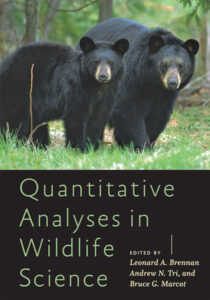 Late in 2019, at the annual meeting of The Wildlife Society in Reno, Nevada, some roguish wag who according to observers looked suspiciously like me, may have, in a conversation with the senior life sciences editor of Johns Hopkins University Press, playfully referred to the then just-released Quantitative Analyses in Wildlife Science as “How to Count Bears.”
Late in 2019, at the annual meeting of The Wildlife Society in Reno, Nevada, some roguish wag who according to observers looked suspiciously like me, may have, in a conversation with the senior life sciences editor of Johns Hopkins University Press, playfully referred to the then just-released Quantitative Analyses in Wildlife Science as “How to Count Bears.”
Of course, as all who engage in wildlife research well know, accurate calculation of populations, as well as predicting growth trends and migrating patterns, is no laughing matter – especially as the field of wildlife biology in general, and management in particular, has over the recent decades become so increasingly focused on quantitative methods.
Therefor for all those entering the field, those presently established in it, and those possessing a serious level of curiosity of how such practices are undertaken, editors Leonard A. Brennan, Andrew N. Tri, and Bruce G. Marcot have assembled a distinguished group of professionals to present “conceptual and quantitative overviews of [the] modern analytical methods” used in both field as well as policy level wildlife conservation work.
Admittedly, this is primarily a book for students and working wildlife management professionals; however that is not to say that it is, or should be, outside the realm of consideration by those with a sincere interest in how wildlife researchers collect and interpret data. As so many aspects of contemporary wildlife conservation revolve around what the number are, how they were collected, and how they are interpreted, most anyone with a serious interest in wildlife conservation would do well to at least understand how the metaphorical sausage is made – even if they’re not making it themselves. To that end, this is most certainly the book from which to best acquire such an understanding.
